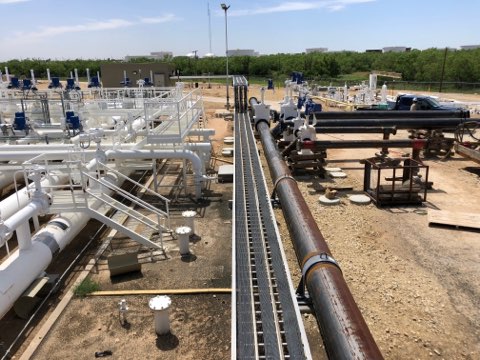All About Oil Field Equipment and Pipeline Equipment: Key Insights and Vital Information
Oil field equipment and pipeline systems play an essential role in the oil and gas sector. They are necessary for the efficient extraction and transport of hydrocarbons. Trick elements, such as drilling rigs and tank, straight effect functional success. Innovations in technology assurance to enhance security and effectiveness. Recognizing these components is important for any individual associated with or interested in this intricate industry, as it sets the stage for much deeper expedition of industry practices.

Review of Oil Field Equipment
As the need for oil remains to grow, understanding the equipment used in oil areas ends up being increasingly crucial. Oil field equipment incorporates a variety of equipment and devices vital for expedition, extraction, and processing. Key parts include piercing rigs, which are essential for reaching oil reservoirs, and manufacturing equipment, such as separators and pumps, that promote the extraction process. Superior Rentals fusion machines. Furthermore, tank play a significant function in holding unrefined oil before transport. Safety tools, including blowout preventers and pressure assesses, assures operational safety and security and efficiency. Each item of tools features cohesively to enhance manufacturing and maintain effective operations. Familiarity with this devices is vital for professionals in the market to assure successful operations and adherence to security requirements
Sorts Of Drilling Rigs and Their Applications
Drilling rigs act as the foundation of oil removal operations, with different kinds designed for particular geological conditions and functional demands. The most common types include rotating boring rigs, which make use of a turning drill bit to permeate the planet, and wire device rigs, recognized for their percussion drilling method. For offshore procedures, jack-up rigs and semi-submersible rigs provide stability and support in marine environments. Furthermore, directional exploration rigs make it possible for drivers to drill at angles, reaching deposits that are not up and down accessible. Each gear kind has distinct advantages, enhancing performance and security based upon the boring atmosphere. Selecting the suitable rig is necessary for optimizing source removal while reducing environmental effect and operational prices.

Vital Pipeline Equipment and Their Features
Pipeline infrastructure is essential for the transport of oil and gas from extraction websites to refining facilities and end-users. Various essential tools components promote this process. Pipes themselves act as the main avenues, made to stand up to high pressure and destructive materials. Pump terminals are important for preserving circulation by increasing pressure along the pipeline. Valves play a vital function in controlling flow and separating sections for upkeep. Additionally, installations and ports ensure safe and secure joints between pipeline sections. Keeping track of systems, consisting of flow meters and stress sensors, are crucial for identifying leakages and maximizing flow prices. Pigging tools is employed for maintenance and cleansing, safeguarding pipeline stability and performance. With each other, these parts develop the foundation of a trustworthy pipeline system.
Advancements and Technologies in Oil and Gas Equipment

Security and Upkeep Practices in the Oil Industry
While the oil market has actually made significant strides in innovation and performance, the importance of robust safety and security and maintenance practices can not be overemphasized. Reliable security methods are necessary to protect workers and the atmosphere, minimizing the danger of crashes and spills. Normal evaluations and maintenance of devices assistance determine potential concerns prior to they rise, guaranteeing functional stability. Educating programs for employees are crucial, stressing the importance of safety awareness and emergency situation feedback procedures. Additionally, adherence to industry regulations and requirements promotes a society of safety and security. Implementing advanced monitoring innovations can additionally improve upkeep methods, enabling real-time analyses of tools problems. Eventually, prioritizing safety and security and maintenance is indispensable to the sustainability and success of the oil sector.
Regularly Asked Inquiries
What Are the Environmental Effects of Oil Field Equipment?
The ecological influences of oil field equipment include habitat devastation, water contamination, and air pollution (Superior Rentals near me). Additionally, devices breakdown can result in spills, negatively impacting wild animals and environments, highlighting the need for rigorous guidelines and tracking
How Is Oil Field Equipment Transported to Remote Locations?
Delivering oil field equipment to remote locations usually entails specialized automobiles, helicopters, or barges. Logistics companies coordinate blog here paths, ensuring tools arrives securely and efficiently, thinking about surface and availability to minimize delays and take full advantage of performance.
What Regulatory Standards Govern Oil Field Equipment?
Regulatory criteria governing oil field equipment mainly consist of safety and security, environmental security, and functional efficiency guidelines. Agencies such as OSHA and EPA implement these regulations to ensure risk-free techniques backhoe digger and minimize ecological influence in oil removal operations.
What Skills Are Needed to Operate Oil Field Equipment?

How Do Oil Rates Impact Equipment Need and Usage?
Oil rates considerably influence tools need and usage. Higher costs normally bring about boosted expedition and manufacturing activities, driving need for machinery. Alternatively, reduced costs might result in minimized operations and decreased demand for equipment.